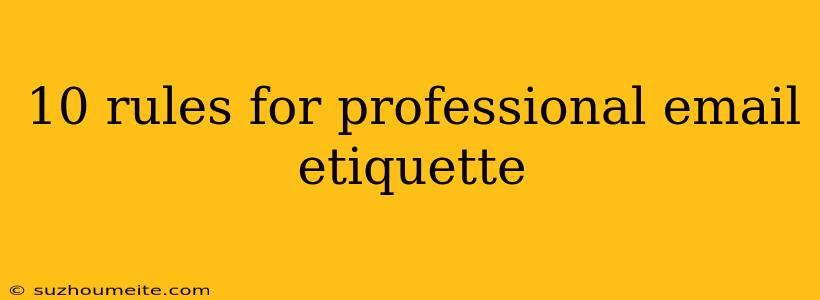10 Rules for Professional Email Etiquette
Effective email communication is essential in a professional setting. It helps to build strong relationships, convey messages efficiently, and maintain a positive image of yourself and your organization. However, with the rise of digital communication, it's easy to forget the importance of proper etiquette. In this article, we'll discuss the top 10 rules for professional email etiquette.
1. Use a Clear and Concise Subject Line
The subject line is the first thing the recipient sees, so make it count. Keep it brief, specific, and relevant to the email content. Avoid using generic subject lines like "Hello" or "Question."
2. Address the Recipient Properly
Begin your email with a formal greeting, addressing the recipient by their title (Mr./Ms./Mrs./Dr.) and last name, unless you have a prior agreement to use first names.
3. Be Clear and Concise in Your Message
Get straight to the point and avoid rambling. Break up long paragraphs into shorter ones, and use bullet points or numbered lists when presenting multiple items.
4. Use a Professional Email Address
Ditch the silly or unprofessional email addresses and create a professional one that includes your name or initials.
5. Proofread and Edit
Typos, grammatical errors, and awkward phrasing can make a negative impression. Take the time to review your email before hitting send.
6. Use a Formal Closing
End your email with a professional closing like "Best regards," "Sincerely," or "Thank you for your time."
7. Include a Clear Call-to-Action
Specify what action you want the recipient to take, whether it's responding to your email, scheduling a meeting, or visiting a website.
8. Use a Professional Email Signature
Create a signature that includes your name, title, company, and contact information. Avoid using overly flashy or distracting designs.
9. Avoid Jargon and Technical Terms
Use language that's accessible to your audience. Avoid using technical terms or jargon that might confuse the recipient.
10. Proofread and Edit (Again!)
Before hitting send, double-check for errors, tone, and content. Ask yourself: "Is this email clear, concise, and professional?"
By following these 10 rules for professional email etiquette, you'll be well on your way to crafting emails that are effective, respectful, and impressive. Remember, the goal of professional email etiquette is to present yourself and your organization in the best possible light.
